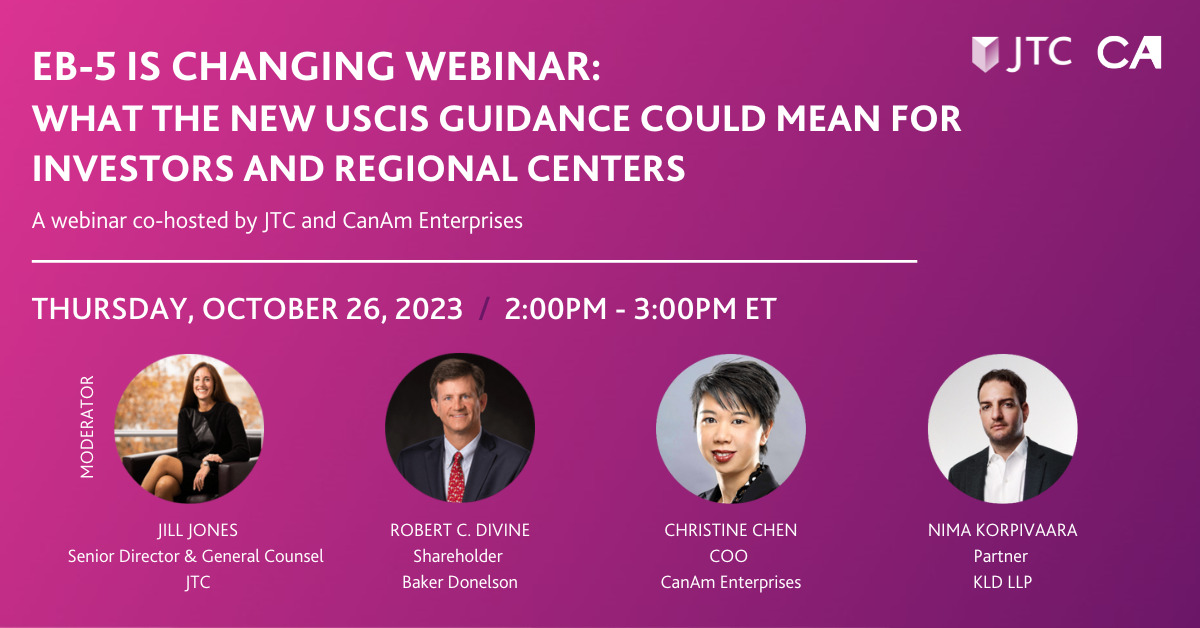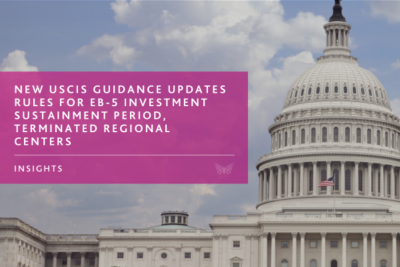The EB-5 Immigrant Investor Program has long been a pathway for foreign investors seeking U.S. residency, but recent legislative reforms and evolving market conditions have significantly shaped its landscape. On The EB-5 Show‘s inaugural episode, hosted by Vivek Tandon, Pete Calabrese, CEO of CanAm Investor Services, provided insights into the state of the EB-5 industry in 2025. The conversation touched upon CanAm’s success, the evolving EB-5 program, project selection criteria, and what investors should consider when embarking on their EB-5 journey.
A Career in EB-5: Pete Calabrese’s Journey
Calabrese’s path to the EB-5 industry was anything but conventional. With a background in financial markets, including experience in trading and investment advisory, he transitioned into EB-5 about a decade ago. His entry into the sector was fueled by a desire to merge investment expertise with meaningful client relationships—an aspect that EB-5 uniquely offers due to its dual nature as both an investment vehicle and an immigration process.
At CanAm, Calabrese found an organization with an unparalleled track record in the EB-5 space. Since its inception, CanAm has sponsored 72 EB-5 projects, raised over $3.5 billion in EB-5 capital, secured more than 5,400 I-526 petition approvals, and facilitated over 2,800 I-829 approvals, leading to permanent U.S. residency for thousands of investors and their families. In addition to its immigration successes, CanAm has returned $2.5 billion to investors, setting a high standard for accountability and performance in the industry.
The Present and Future of EB-5
According to Calabrese, the EB-5 industry is in a transformative phase following the passage of the EB-5 Reform and Integrity Act of 2022. While the program faced turbulence in the past—including a lapse in 2021—the new legislation introduced increased oversight and protections for investors, ultimately strengthening confidence in EB-5 as a viable immigration pathway.
One of the major takeaways from the discussion was the evolving nature of EB-5 investment categories. The introduction of visa set-asides for rural and high-unemployment area projects has reshaped investor priorities. Calabrese emphasized that these changes create new opportunities, especially for investors looking to minimize visa wait times. However, he cautioned that investors should not rush into projects solely based on visa set-asides; instead, they should carefully evaluate all aspects of a project before committing capital.
CanAm’s Approach to Project Selection
Calabrese highlighted CanAm’s rigorous due diligence process, which has been integral to its success. Unlike some EB-5 sponsors, CanAm does not operate as a vertically integrated entity, allowing it to independently assess project viability and structure investments to prioritize investor success. This means:
- Extensive Vetting: CanAm evaluates a vast number of potential projects before selecting the few that meet its stringent criteria. Over the years, CanAm has reviewed nearly ten times as many projects as it has ultimately sponsored.
- Prioritizing Stability: Whether it’s real estate developments, infrastructure projects, or large-scale commercial ventures, CanAm ensures that projects have solid financial backing, strong market demand, and reliable job creation potential.
- Structured as Debt Investments: CanAm structures EB-5 investments as loans rather than equity, allowing for greater security, clear repayment timelines, and prioritization in the capital stack.
Key Lessons from the EB-5 Industry
While discussing challenges, Calabrese acknowledged that, like any investment, EB-5 carries risks. However, CanAm’s approach to transparency and investor communication has been a key factor in mitigating uncertainty. He emphasized that every investor should conduct thorough due diligence and seek out sponsors who provide clear disclosures, regular project updates, and open communication.
The EB-5 industry has learned valuable lessons over the past two decades, including:
- The Importance of Transparency: Investors must be fully informed about project risks and market conditions. CanAm ensures this through consistent reporting and investor relations.
- The Role of Third-Party Audits: CanAm voluntarily undergoes third-party audits to validate its track record, helping to instill confidence among investors.
- Investor-Centric Decision-Making: Unlike some regional centers that may prioritize volume over quality, CanAm focuses on investor outcomes, ensuring that projects are structured with the highest probability of success.
Advice for Prospective EB-5 Investors
Calabrese provided a clear message for individuals considering EB-5: Act strategically, but do not rush. With increasing interest in the program, particularly in rural and high-unemployment set-asides, visa availability may change in the near future. He urged investors to work with experienced professionals, carefully document their source of funds, and select projects with strong fundamentals rather than being swayed solely by marketing tactics.
Additionally, he highlighted that while concurrent filing remains a major advantage for U.S.-based investors, those interested in EB-5 should move forward sooner rather than later to secure favorable priority dates before potential retrogression occurs.
The Broader Impact of EB-5 Investments
Beyond individual investors, EB-5 plays a significant role in economic development. Calabrese shared success stories of projects financed through EB-5 that have had a transformative impact on local economies, including:
- The Pennsylvania Convention Center: A key infrastructure project that generated jobs and economic activity.
- Brightline High-Speed Rail: A major transportation project connecting Miami to Orlando, improving connectivity and boosting regional growth.
- Pfizer’s Global Headquarters: A state-of-the-art commercial development contributing to job creation in New York.
These projects not only fulfilled their EB-5 job creation mandates but also delivered long-term economic benefits, reinforcing EB-5’s role as a valuable tool for U.S. economic development.
Looking Ahead: EB-5 Under Future Administrations
One of the lingering questions in the EB-5 space is how political changes, particularly a potential second Trump administration, could impact the program. Calabrese noted that EB-5 historically received support from both major political parties, including during Trump’s first term. While broader immigration policies may evolve, he does not foresee drastic changes to EB-5, given its role in job creation and economic development.
However, he advised investors to stay informed and adaptable, as regulatory and procedural adjustments are always a possibility in the immigration landscape.
Final Thoughts: A Promising Future for EB-5
As the discussion wrapped up, Calabrese reaffirmed his optimism about EB-5’s future. With new legislative protections, evolving project structures, and increased investor awareness, the program is in a strong position for sustained growth. For those considering an EB-5 investment, now is an opportune time—provided they conduct thorough due diligence and align themselves with reputable sponsors like CanAm.
For investors seeking U.S. residency through EB-5, the key takeaway from this insightful discussion is clear: success in EB-5 depends on choosing the right project, working with the right partners, and understanding the program’s long-term benefits beyond just financial returns. As EB-5 continues to evolve, informed decision-making will be the cornerstone of a successful investment journey.
Dive Deeper Into EB-5:
- Smart Strategies for Choosing EB-5 Investment Projects to Meet Your Immigration and Financial Goals
- Understanding the EB-5 Investment Landscape in a Post-Election Era
- The Promise of EB-5 in 2025: A Pathway to Shared Prosperity




